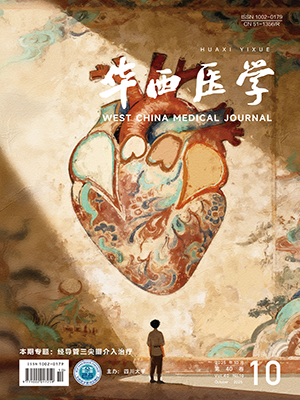| 1. |
叶慧, 宗志勇, 吕晓菊. 2017 年版美国疾病预防控制中心手术部位感染预防指南解读.中国循证医学杂志, 2017, 17(7): 745-750.
|
| 2. |
石喜之, 王济峰, 周涌, 等. 手术后切口感染与抗生素合理应用的评价. 第四军医大学学报, 2012, 21(27): 897-898.
|
| 3. |
Talbot TR. Diabetes mellitus and cardiothoracic surgical site infections. Am J Infect Control, 2005, 33(6): 353-359.
|
| 4. |
叶应妩, 王毓三, 申子瑜. 全国临床检验操作规程. 3 版. 南京: 东南大学出版社, 2006: 750.
|
| 5. |
中华人民共和国卫生部. 医院感染诊断标准(试行). 中华医学杂志, 2001, 81(5): 314-320.
|
| 6. |
Clinical and Laboratory Standards Institute. M100-S24: performance standards for antimicrobial susceptibility testing; 24th informational supplement. (2014-02-23)[2017-12-12]. http://www.gxccl.com/download/upload/CLSIM100-S24%E8%8B%B1%E6%96%87%E7%89%88.pdf.
|
| 7. |
顾红红, 应群芳. 妇产科住院患者医院感染特点及相关因素分析. 中华医院感染学杂志, 2011, 21(6): 1125-1127.
|
| 8. |
李霈, 袁丽芬, 邓刚. 妇科手术腹部切口感染影响因素及预防对策. 中华医院感染学杂志, 2014, 24(15): 3847-3884.
|
| 9. |
石娜, 徐卫, 薛利霞, 等. 恶性肿瘤患者医院败血症危险因素的病例对照研究. 中华医院感染学杂志, 2009, 19(11): 1358-1359.
|
| 10. |
郑媛, 张玲, 焦成元, 等. 外科手术部位感染目标性监测分析. 华西医学, 2014, 29(3): 428-431.
|
| 11. |
阎玉矿, 刘辉, 李德宁, 等. 糖尿病患者腹部切口感染的临床分析. 中华医院感染学杂志, 2005, 15(8): 870-872.
|
| 12. |
陈东科, 孙长贵. 实用临床微生物学检验与图谱. 北京: 人民卫生出版社, 2011.
|
| 13. |
尹美玲, 邓芳, 樊平, 等. 结直肠癌患者手术部位感染的病原学及药敏分析. 临床输血与检验, 2017, 19(4): 386-389.
|
| 14. |
旷凌寒, 王嘉敏, 周伟, 等. 新生儿科下呼吸道感染病原菌分布及耐药性分析. 华西医学, 2014, 29(3): 417-419.
|
| 15. |
陈龙, 张淑珍, 耿丽殊, 等. 妇科住院患者医院感染病原菌特点及耐药性分析. 中华医院感染学杂志, 2010, 20(16): 2494-2495.
|
| 16. |
Tuuli MG, Rampersad RM, Carbone JF, et al. Staples compared with subcuticular suture for skin closure after cesarean delivery: a systematic review and meta-analysis. Obstet Gynecol, 2011, 117(3): 682-690.
|
| 17. |
张小红, 罗丽霞. 腹部手术切口感染危险因素调查分析及预防. 南华大学学报: 医学版, 2010, 38(2): 301-302.
|
| 18. |
Sutkin G, Alperin M, Meyn L, et al. Symptomatic urinary tract infections after surgery for prolapse and/or incontinence. Int Urogynecol J, 2010, 21(8): 955-961.
|




